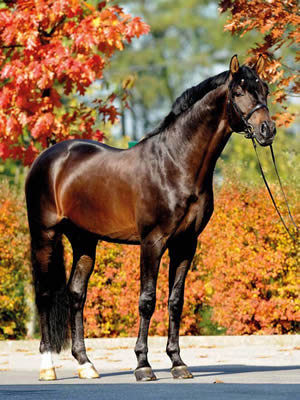History
The Holsteiner or Holstein horse is the product of systematic breeding that has been ongoing in the northernmost province of Germany, Schleswig-Holstein, since the thirteenth century. This area is one of the most successful horse breeding regions in Germany and the Holsteiner is one of Germany's oldest breeds of warmblood. The Holsteiner horse traces its ancestry to Neapolitan, Spanish and Oriental foundation stock that was carefully crossed with the native stock of the region. Originally the horse was valued by German farmers for its strength, steadiness and reliability, and by the military for its courage and ability.
The first written records of Holsteiner horse breeding date back to the thirteenth century when the Count of Holstein and Storman, Gerhard I, granted grazing rights to the monastery at Uetersen to the privately-owned land around the cloister. The monks continued to breed fine horses until the time of the Reformation when the properties of the monasteries were transferred to private landowners. Realizing the importance of these horses both on the farm and as dependable warhorses, these landowners continued the work begun by the monks.
As early as 1686 laws were passed in Schleswig-Holstein to insure the quality of the breed and incentives were often offered to encourage good breeding. Throughout the seventeenth and eighteenth century the reputation of the Holsteiner breed grew throughout Europe with over 10,000 horses exported in the year 1797.
As the need for warhorses declined, British Yorkshire Coach horses and Cleveland Bay stallions were used in the nineteenth century to produce a fine, high-stepping carriage horse. After World War II, Thoroughbred blood was introduced to the breed which added refinement and jumping ability to the unique character of the Holsteiner. The breed has emerged as one of the great German sporting horses, particularly suited for jumping, dressage, driving and eventing and has been very influential the the development of other warmblood breeds.
Today, the Holsteiner can be found finishing at the top of the standings in most international equestrian eventing and driving competitions including both the Olympic Games and World Championships.
Behavior
Holsteiners are well-balanced, strong-nerved, reliable, and bold
Function
Holsteiners that reach the upper echelons of dressage are less common, but do exist. Successive generations of selection for jumping power have given most Holsteiners a powerful "engine." The studbook was ranked No. 8 in international dressage by the World Breeding Federation for Sporthorses in 2008. Cheenook, mentioned above as the No. 1 sire of USEF Hunters in 2008, competed up to Intermediare I dressage and participated twice in the German Federal Dressage Horse Championships. Holsteiners currently competing in international dressage include Liebling II (Lorentin I), Amicelli (Amigo), The Lion King B (Landos), Lanzaro (Lavall I), Samsung Cinque Cento (Cambridge), and Jamiro Rosso (Caletto). Holstein's impact on dressage is not limited to these horses. The No. 6 sire of international dressage horses, Flemmingh, had two Holsteiner parents: Lacapo, a Landgraf son, and Texas, a Carneval daughter. True to his ancestry, Flemmingh is known for producing knee action. Also on the list of top sires of FEI dressage horses are No. 14 Contango, who stands in the United States, and No. 25 Carpaccio. Like Cheenook, Carpaccio was also sired by Caretino. Holsteiners to prove themselves at the Olympic level include both the gold medal in the individual competition at the 1976 Montreal Olympics, won by Granat. The Marlon xx son, Montevideo, was a member of the gold medal-winning dressage team in Los Angeles.
Seen here at Badminton in 2007, the Holsteiner Marius and his rider Hinrich Romeike went on to win the gold medal in eventing at the 2008 Beijing Olympics. Most Holsteiners with the speed to succeed in eventing have a Thoroughbred sire. As a studbook, they are ranked No. 6 based on performances in international eventing.






